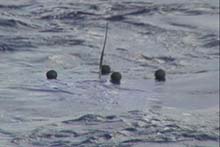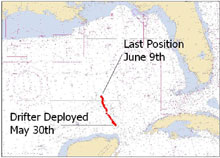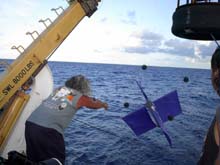Ride the Stream
Note: As of June 9, 2001, the position of both drifter buoys is unknown.
You can track the “liquid wind” that connects the various areas of the western Atlantic by checking the progress of two satellite-tracked drifter buoys that will be deployed during the Islands in the Stream Expedition. Drifters come in a variety of shapes and sizes, but all do basically the same thing. They act like bottles carrying messages of hope, thrown to sea by sailors marooned on remote islands and wandering with the ocean currents. But these drifters don’t need to wash up on some distant shore before their messages are received. They transmit a signal for up to a year to polar orbiting satellites, which calculate their position, revealing it to the world.
Cowboy of the Currents
The buoys will drift with the currents while explorers and scientists do submersible and diving work. One will be placed in the Yucatan Current off Mexico. We call it “Roving Russell, the drifting datameister, Cowboy of the Currents.” If our predictions are right, Roving Russell will shoot to the north into the Gulf, then turn south with the Loop Current and leave the Gulf, becoming part of the Gulf Stream. It could, however, get caught up in one of the spin-off eddies and head into the western Gulf, but that is probably not likely.
Easy Rider of the Eddy
The other drifter will be placed in the water near Gladden Spit, an area along the Barrier Reef in Belize where mutton snapper spawn every May. We call it “Dizzy, the dawdlin’ drifter, Easy Rider of the Eddy” because we think it will probably drift in circles in the eddy that sits just off Belize, just west of the Caribbean Current. We don’t know how long this might happen, but eventually the drifter should be swept up into the Yucatan Current and follow fast on the heels of Roving Russell.

The drifter buoy Roving Russell begins its journey in the currents.
By tracking drifters like Roving Russell and Dizzy, scientists are able to visualize the large-scale patterns of water movement in the oceans. These currents serve as highways, providing a ready means transport for plant spores, animal larvae, and adult creatures. By knowing the current patterns, scientists can begin to assess the connectivity of biological communities in a region and identify source areas that are critically important to the replenishment and survival of the region as a whole.
So sit back and enjoy the ride!
For more information
Read more about ocean currents, and the importance of drifters in oceanography
Read more information on global buoy data from Fisheries and Ocean Canada
![]()
Sign up for the Ocean Explorer E-mail Update List.













































